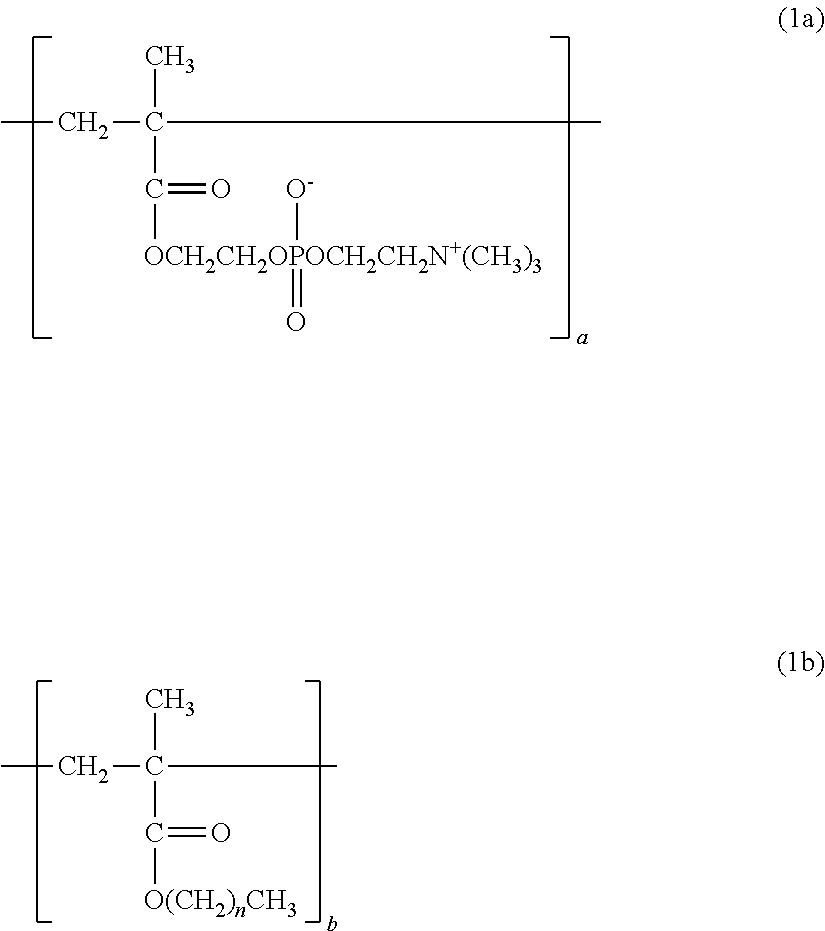Polymer and crosslinked body thereof
a crosslinked body and polymer technology, applied in the field of polymer and crosslinked body, can solve the problems of coating peeling, coating peeling, and insufficient durability of coating,
- Summary
- Abstract
- Description
- Claims
- Application Information
AI Technical Summary
Benefits of technology
Problems solved by technology
Method used
Image
Examples
synthesis example 1
[0101]18.2335 g (0.0618 mol) of 2-methacryloyloxyethyl-2-trimethylammonioethyl phosphate (MPC), 19.0257 g (0.134 mol) of butyl methacrylate (BMA), and 2.7408 g (0.0103 mol) of 4-methacryloyloxybenzophenone (MBP) were dissolved in 155.1124 g of ethanol (EtOH). The solution was loaded into a 300-milliliter four-necked flask with a temperature gauge and a condenser, and nitrogen was blown into the flask for 30 minutes. After that, 4.8876 g (2.98 mmol) of a 10 wt % solution of azobisisobutyronitrile (AIBN) in EtOH was added to the solution at 65° C., and a polymerization reaction was performed for 6 hours. Thus, a polymer formed of the monomer feed composition was obtained. After the completion of the reaction, the polymer was purified by precipitation in diethyl ether. The measurement results of the 1H NMR and weight-average molecular weight of the resultant polymer are shown below and in Table 1.
Polymer of Synthesis Example 1
(1H NMR)
[0102]0.70-1.35 ppm (—CH3), 1.35-2.60 ppm (—CH2—C—, ...
synthesis example 2
[0104]28.7540 g (0.0974 mol) of MPC, 6.9239 g (0.0487 mol) of BMA, and 4.3221 g (0.0162 mol) of MBP were dissolved in 155.1124 g of EtOH. The solution was loaded into a 300-milliliter four-necked flask with a temperature gauge and a condenser, and nitrogen was blown into the flask for 30 minutes. After that, 4.8876 g (2.98 mmol) of a 10 wt % solution of AIBN in EtOH was added to the solution at 65° C., and a polymerization reaction was performed for 6 hours. Thus, a polymer formed of the monomer feed composition was obtained. After the completion of the reaction, the polymer was purified by precipitation in diethyl ether. The measurement results of the 1H NMR and weight-average molecular weight of the resultant polymer are shown below and in Table 1.
Polymer of Synthesis Example 2
(1H NMR)
[0105]0.70-1.35 ppm (—CH3), 1.35-2.60 ppm (—CH2—C—, —O—CH2—CH2—CH2—CH3), 3.15-3.40 ppm (—N+(CH3)3), 3.60-3.80 ppm (—CH2—N+(CH3)3), 3.80-4.15 ppm (—P—O—CH2—, —C(O)—O—CH2—CH2—), 4.15-4.40 ppm (—O—CH2—C...
synthesis example 3
[0107]35.5350 g (0.120 mol) of MPC, 4.0644 g (0.0286 mol) of BMA, and 0.4006 g (0.00150 mol) of MBP were dissolved in 155.1124 g of EtOH. The solution was loaded into a 300-milliliter four-necked flask with a temperature gauge and a condenser, and nitrogen was blown into the flask for 30 minutes. After that, 4.8876 g (2.98 mmol) of a 10 wt % solution of AIBN in EtOH was added to the solution at 65° C., and a polymerization reaction was performed for 6 hours. Thus, a polymer formed of the monomer feed composition was obtained. After the completion of the reaction, the polymer was purified by precipitation in diethyl ether. The measurement results of the 1H NMR and weight-average molecular weight of the resultant polymer are shown below and in Table 1.
Polymer of Synthesis Example 3
(1H NMR)
[0108]0.70-1.35 ppm (—CH3), 1.35-2.60 ppm (—CH2—C—, —O—CH2—CH2—CH2—CH3), 3.15-3.40 ppm (—N+(CH3)3), 3.60-3.80 ppm (—CH2—N+(CH3)3), 3.80-4.15 ppm (—P—O—CH2—, —C(O)—O—CH2—CH2—), 4.15-4.40 ppm (—O—CH2—C...
PUM
| Property | Measurement | Unit |
|---|---|---|
| molar ratio | aaaaa | aaaaa |
| molar ratio | aaaaa | aaaaa |
| molar ratio | aaaaa | aaaaa |
Abstract
Description
Claims
Application Information
 Login to View More
Login to View More - R&D
- Intellectual Property
- Life Sciences
- Materials
- Tech Scout
- Unparalleled Data Quality
- Higher Quality Content
- 60% Fewer Hallucinations
Browse by: Latest US Patents, China's latest patents, Technical Efficacy Thesaurus, Application Domain, Technology Topic, Popular Technical Reports.
© 2025 PatSnap. All rights reserved.Legal|Privacy policy|Modern Slavery Act Transparency Statement|Sitemap|About US| Contact US: help@patsnap.com



